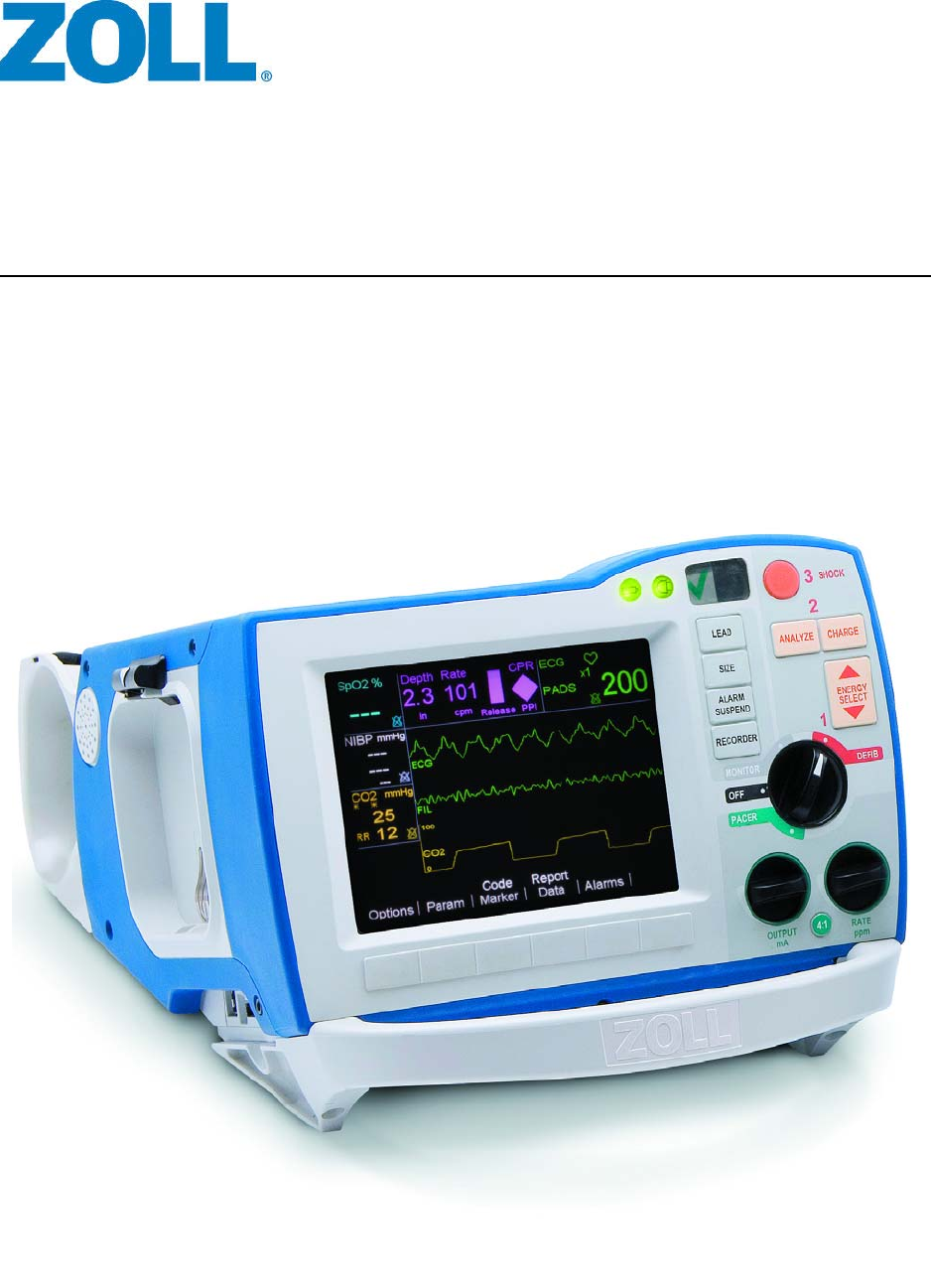Zoll Medical RDC002 Z-RS-DC002 User Manual 9650 0912 01 SF J
Zoll Medical Corp Z-RS-DC002 9650 0912 01 SF J
Contents
- 1. User Manual
- 2. user manual
User Manual

R Series® ALS Operator’s Guide
9650-0912-01 Rev. J

The issue date for the R Series Operator’s Guide ALS (REF 9650-0912-01 Rev. J) is June 2013.
If more than 3 years have elapsed since the issue date, contact ZOLL Medical Corporation to determine if
additional product information updates are available.
Copyright © 2013 ZOLL Medical Corporation. All rights reserved.
R Series, M Series, pedi-padz, pro-padz, stat-padz, CodeNet, Real CPR Help, RescueNet, See-Thru CPR,
Code-Ready, SurePower, OneStep, Smart Alarms, CPR Index, Defib Mentor, Rectilinear Biphasic, and ZOLL
are trademarks or registered trademarks of ZOLL Medical Corporation in the United States and/or other
countries.
Masimo is a registered trademark of Masimo Corporation in the United States and/or other countries.
All other trademarks are property of their respective owners.
0123
ZOLL Medical Corporation
269 Mill Road
Chelmsford, MA USA
01824-4105
ZOLL International Holding B.V.
Newtonweg 18
6662 PV ELST
The Netherlands

9650-0912-01 Rev. J ZOLL R Series Operator’s Guide i
Table of Contents
Chapter 1 General Information
Product Description ............................................................................................................1-1
How to Use This Manual.....................................................................................................1-2
Operator’s Guide Updates..................................................................................................1-3
Unpacking........................................................................................................................... 1-3
Symbols Used on the Equipment ....................................................................................... 1-3
Conventions........................................................................................................................ 1-6
Defibrillator Function........................................................................................................... 1-6
Intended Use — Manual Operation ............................................................................ 1-6
Intended Use — ECG Monitoring ............................................................................... 1-7
Intended Use — Real CPR Help ................................................................................ 1-7
Defibrillator Complications .......................................................................................... 1-7
Defibrillator Output Energy ......................................................................................... 1-7
External Pacemaker (Optional)........................................................................................... 1-8
Intended Use — Pacemaker ....................................................................................... 1-8
Pacemaker Complications .......................................................................................... 1-9
Pediatric Pacing ........................................................................................................ 1-10
Intended Use — SpO2 Monitoring .................................................................................... 1-10
Intended Use — EtCO2 Monitoring................................................................................... 1-10
Intended Use — NIBP ...................................................................................................... 1-11
ECG Monitoring ................................................................................................................ 1-11
Recorder Function ............................................................................................................ 1-11
Paddles and Electrodes.................................................................................................... 1-12
Batteries............................................................................................................................ 1-12
Code-Ready System......................................................................................................... 1-13
Safety Considerations....................................................................................................... 1-13
Warnings........................................................................................................................... 1-14
Operator Safety ........................................................................................................ 1-15
Patient Safety ........................................................................................................... 1-16
Cautions............................................................................................................................ 1-18
Restarting the Defibrillator ................................................................................................ 1-18
FDA Tracking Requirements............................................................................................. 1-19
Notification of Adverse Events .................................................................................. 1-19
Software License .............................................................................................................. 1-20
Service.............................................................................................................................. 1-20
The ZOLL Serial Number.................................................................................................. 1-21

TABLE OF CONTENTS
ii www.zoll.com 9650-0912-01 Rev. J
Chapter 2 Product Overview
Defibrillator Controls and Indicators....................................................................................2-1
The Front Panel .......................................................................................................... 2-3
Display Screen ............................................................................................................ 2-5
Patient Cables and Connectors .................................................................................. 2-7
External Paddles ......................................................................................................... 2-9
Working with Menus.......................................................................................................... 2-11
Defib Mentor Mode (Optional) .................................................................................. 2-12
Common Tasks................................................................................................................. 2-13
Replacing a Battery Pack ......................................................................................... 2-13
Adjusting Display Brightness .................................................................................... 2-13
Using Code Markers ................................................................................................. 2-14
Chapter 3 Manual Defibrillation
Emergency Defibrillation Procedure with Paddles..............................................................3-1
Determine the Patient’s Condition Following Local Medical Protocols ....................... 3-1
Begin CPR Following Local Medical Protocols. .......................................................... 3-2
1 Select DEFIB ........................................................................................................... 3-2
2 Charge Defibrillator .................................................................................................. 3-4
3 Deliver Shock ...........................................................................................................3-5
Autoclavable External Paddles........................................................................................... 3-5
Emergency Defibrillation Procedure with Hands-Free Therapy Electrodes........................ 3-6
Determine the Patient’s Condition Following Local Medical Protocols ....................... 3-6
Begin CPR Following Medical Protocols .................................................................... 3-6
Prepare Patient ........................................................................................................... 3-6
1 Select DEFIB ........................................................................................................... 3-8
2 Charge Defibrillator .................................................................................................. 3-9
3 Deliver Shock .........................................................................................................3-10
Autoclavable Electrodes ................................................................................................... 3-10
Chapter 4 Advisory Defibrillation
Advisory Defibrillation Procedure........................................................................................ 4-2
Determine the Patient’s Condition Following Local Medical Protocols ....................... 4-2
Begin CPR Following Local Medical Protocols ........................................................... 4-2
Prepare Patient ........................................................................................................... 4-2
1 Select DEFIB ........................................................................................................... 4-2
2 Press ANALYZE Button ........................................................................................... 4-3
3 Press SHOCK .......................................................................................................... 4-5
Advisory Function Messages.............................................................................................. 4-7
Warning Messages ............................................................................................................. 4-7

9650-0912-01 Rev. J ZOLL R Series Operator’s Guide iii
Chapter 5 Synchronized Cardioversion
Synchronized Cardioversion Procedure .............................................................................5-2
Determine the Patient’s Condition and Provide Care Following Local Medical
Protocols .................................................................................................................. 5-2
Prepare Patient ........................................................................................................... 5-2
1 Select DEFIB ........................................................................................................... 5-3
2 Charge Defibrillator .................................................................................................. 5-4
3 Deliver SHOCK ........................................................................................................ 5-5
Remote Synchronized Cardioversion Procedure................................................................ 5-5
Determine the Patient’s Condition and Provide Care Following Local Medical
Protocols .................................................................................................................. 5-6
Prepare Patient ........................................................................................................... 5-6
1 Select DEFIB ........................................................................................................... 5-6
2 Charge Defibrillator .................................................................................................. 5-7
3 Deliver SHOCK ........................................................................................................ 5-7
Chapter 6 Real CPR Help
Real CPR Help Field........................................................................................................... 6-2
CPR Index (Optional/Adult Only) ................................................................................ 6-2
CPR Idle Time Display ................................................................................................ 6-2
CPR Rate and Depth Display ..................................................................................... 6-2
Compression Release Bar (Adult only) .......................................................................6-3
CPR Metronome ......................................................................................................... 6-3
Fully Release prompt .................................................................................................. 6-3
CPR Voice Prompts (Adult only).........................................................................................6-4
Chest Compressions Waveform ......................................................................................... 6-4
Displaying the CPR Waveform ........................................................................................... 6-4
Chapter 7 See-Thru CPR (Optional)
Using See-Thru CPR .......................................................................................................... 7-2
Examples .................................................................................................................... 7-2
Chapter 8 Noninvasive Temporary Pacing
(Optional)
Noninvasive Temporary Pacing .......................................................................................... 8-2
Determine Patient Condition and Provide Care Following Local Medical Protocols. .. 8-2
Prepare the Patient ..................................................................................................... 8-2
1 Apply ECG Electrodes/Hands-Free Therapy Electrodes ......................................... 8-2
2 Turn Selector Switch to PACER .............................................................................. 8-3
3 Set Pacer Rate ........................................................................................................ 8-3
4 Set Pacer Output ..................................................................................................... 8-4
5 Determine Capture .................................................................................................. 8-5
6 Determine Optimum Threshold ................................................................................ 8-6

TABLE OF CONTENTS
iv www.zoll.com 9650-0912-01 Rev. J
Special Pacing Applications................................................................................................ 8-7
Standby Pacing ........................................................................................................... 8-7
Asynchronous Pacing ................................................................................................. 8-7
Pediatric Pacing .......................................................................................................... 8-8
Chapter 9 ECG Monitoring
Preparations........................................................................................................................ 9-2
Electrode Placement........................................................................................................... 9-2
Monitoring Electrodes Attachment...................................................................................... 9-3
Monitoring the Patient’s ECG.............................................................................................. 9-5
Set the Controls ..........................................................................................................9-5
Implanted Pacemakers....................................................................................................... 9-5
5-Lead Monitoring...............................................................................................................9-6
Simultaneous 3-Lead Printing ..................................................................................... 9-7
See-Thru CPR Filter (Optional) .................................................................................. 9-7
Adding Traces to Be Displayed .................................................................................. 9-7
Printing the ECG on a Stripchart......................................................................................... 9-8
Diagnostic Bandwidth ................................................................................................. 9-8
Alarms................................................................................................................................. 9-8
Setting Alarm Limits .................................................................................................... 9-8
Heart Rate Alarm Limits ..............................................................................................9-9
Vital Sign Alarms ...................................................................................................... 9-10
Suspending and Silencing Alarms ............................................................................ 9-10
Smart Alarms ............................................................................................................ 9-11
Chapter 10 Event Records and Reports
Summary Report............................................................................................................... 10-1
Summary Report Formats ........................................................................................ 10-2
Printing the Entire Summary Report ......................................................................... 10-7
Printing a Partial Summary Report ........................................................................... 10-8
Full Disclosure Recording................................................................................................. 10-8
Incident Logs .................................................................................................................... 10-8
Printing an Incident Log ............................................................................................10-8
Erasing Summary Report and Full Disclosure.................................................................. 10-9
Manual Erasure ........................................................................................................ 10-9
Automatic Erasure .................................................................................................... 10-9
Formatting the Disk ................................................................................................... 10-9
Related Messages ............................................................................................................ 10-9
Chapter 11 File Transfer
Transferring Files to an External Device........................................................................... 11-1
Wi-Fi (Optional)................................................................................................................. 11-2
Installing or Removing a Compact Flash Card ................................................................. 11-2

9650-0912-01 Rev. J ZOLL R Series Operator’s Guide v
Transferring a Full Disclosure File to a Compact Flash Card ........................................... 11-3
Transferring Device Check and Activity Log Files to a Compact Flash Card ................... 11-3
Transferring Files Through the USB Port (Optional)......................................................... 11-4
Transferring Full Disclosure Files Through Wi-Fi (Optional)............................................. 11-5
Transferring Device Check and Activity Log Files Through Wi-Fi (Optional).................... 11-6
Related Wi-Fi Messages ........................................................................................... 11-7
Chapter 12 Maintenance
Routine Procedures .......................................................................................................... 12-2
Daily Visual Inspection ..............................................................................................12-2
Code Readiness Test ............................................................................................... 12-3
Manual Defibrillator Testing .............................................................................................. 12-3
Defibrillator Testing with Paddles .............................................................................12-4
Defibrillator Testing with Hands-Free Therapy Electrodes .......................................12-5
Pacer Testing ............................................................................................................ 12-5
Recorder Check ........................................................................................................ 12-6
Code Readiness Log ................................................................................................ 12-6
Setting Time and Date .............................................................................................. 12-8
Cleaning the R Series Unit ....................................................................................... 12-8
Loading Stripchart Paper .......................................................................................... 12-9
Cleaning the Print Head .......................................................................................... 12-10
Operator’s Checklist for R Series Product .............................................................12-11
Chapter 13 Troubleshooting
Code-Ready .............................................................................................................. 13-1
Monitor ......................................................................................................................13-2
Recorder ................................................................................................................... 13-3
Pacer ........................................................................................................................ 13-4
Defibrillator ................................................................................................................ 13-5
AC Charger ............................................................................................................... 13-7
CPR .......................................................................................................................... 13-7
Appendix A Specifications
Defibrillator Specifications...................................................................................................A-2
Battery Pack Specifications ........................................................................................A-6
IEC 60601-1-2 Specifications .............................................................................................A-7
Electromagnetic Emissions Declaration .....................................................................A-7
Electromagnetic Immunity Declaration (EID) ..............................................................A-8
EID for Life-Support Functions ...................................................................................A-9
Recommended Separation Distances from RF Equipment for the R Series
Life-Support Functions ...........................................................................................A-10
EID for Non–Life-Support Functions .........................................................................A-11
Recommended Separation Distances from RF Equipment for the R Series
Non–Life-Support Functions ...................................................................................A-12

TABLE OF CONTENTS
vi www.zoll.com 9650-0912-01 Rev. J
R Series Rectilinear Biphasic Waveform Characteristics .................................................A-13
Clinical Trial Results for the Biphasic Waveform ..............................................................A-25
Randomized Multicenter Clinical Trial for Defibrillation of Ventricular Fibrillation
(VF) and Ventricular Tachycardia (VT) ...................................................................A-25
Randomized Multi-Center Clinical trial for Cardioversion of Atrial Fibrillation (AF) ...A-26
Synchronized Cardioversion of Atrial Fibrillation ......................................................A-27
ECG Rhythm Analysis Algorithm Accuracy ......................................................................A-29
Appendix B R Series Accessories
Appendix C Wi-Fi Radio Module Information

9650-0912-01 Rev. J ZOLL R Series Operator’s Guide 1–1
Chapter 1
General Information
Product Description
The ZOLL® RSeries
® products combine a defibrillator, ECG display, advanced monitoring
capabilities, and Noninvasive Transcutaneous Pacing (NTP) with communication, data printing
and recording capabilities in a single lightweight portable instrument. The unit has been
designed for all resuscitation situations and its small, compact, lightweight design makes it
ideal for accompanying patients during transport. The product is powered by AC mains and an
easily replaced battery pack that is quickly recharged in the device when it is connected to AC
mains. In addition, the unit’s battery may be recharged and tested using a ZOLL SurePower™
Battery Charger.
The product is designed for use in the hospital. All of its ruggedized features add to its
durability in hospital applications.
The R Series is a versatile manual/advisory external defibrillator. When operating in the
manual configuration, the device operates as a conventional defibrillator where the device’s
charging and discharging are fully controlled by the operator. In advisory mode, some of the
features of the device are automated and a sophisticated algorithm is used to identify shockable
ECG rhythms (VF and wide complex VT >150 bpm) that should be treated by defibrillator
shock delivery. Depending on local protocols, the unit may be configured to automatically
analyze the ECG, charge the defibrillator (if appropriate), and prompt the operator to PRESS
SHOCK between periods of CPR.
The R Series unit assists caregivers during cardiopulmonary resuscitation (CPR) by evaluating
the rate and depth of chest compressions and providing feedback to the rescuer.
There are multiple models of the R Series defibrillator that can contain a variety of
functions. Your model may not contain all of the functions that are documented in this
manual. Those features that are not contained in all models are specified as optional.

CHAPTER 1GENERAL INFORMATION
1–2 www.zoll.com 9650-0912-01 Rev. J
Real CPR Help® requires the use of OneStep™ CPR electrodes or OneStep Complete
electrodes. When using these pads, the displayed ECG waveforms can be adaptively filtered,
using the See-Thru CPR® feature, to reduce the artifact caused by chest compressions.
The R Series is a Code-Ready® defibrillator. It extends testing beyond shock delivery and
checks more than 40 measures of readiness, including the presence of the correct cables and
electrodes, the type of electrode, and other important electronic functions. The R Series also
verifies the condition and expiration date of OneStep electrodes. This code readiness testing
can occur automatically, without disconnecting electrodes or paddles, or requiring additional
equipment to test shock delivery. The system also provides a printed, or electronic log to alert
hospital personnel of any defibrillator functions or accessories that are compromised in
advance of a code.
Some R Series models include an optional transcutaneous pacemaker consisting of a pulse
generator and ECG sensing circuitry. The pacing option supports both demand and
asynchronous noninvasive pacing for adult, pediatric, or neonatal patients. OneStep Pacing
electrodes and OneStep Complete electrodes allow demand pacing and ECG monitoring
without separate ECG electrodes when the R Series is used with the OneStep Pacing cable.
Information regarding the unit’s operation, ECG, and other physiological waveforms are
displayed on a large 6.5 inch (16.5 cm) diagonal display which provides high contrast and
visibility under virtually all lighting conditions. Operating and warning messages are displayed
on the monitor, and the unit can also be configured with voice prompts to alert the user to unit
status. The R Series performs code readiness testing when the unit is OFF but connected to
AC power, when the defibrillator is initially turned on, and periodically during operation.
An annotating strip chart recorder is included to provide immediate documentation as well as
summary report functions about patient care and treatment.
A sophisticated data collection system, including summary report, printer, and multiple
communication ports is available for this unit. The stored data can be reviewed and archived on
a properly equipped personal computer using ZOLL CodeNet® Central software or ZOLL
RescueNet® Code Review software. R Series data files may be transferred to a PC using USB
or Compact Flash cards or Wi-Fi.
R Series products are intended for use in Manual mode by personnel certified by appropriate
federal, state, or local government authority to provide advanced life support care.
How to Use This Manual
The R Series Operator’s Guide provides information operators need for the safe and effective
use and care of the R Series products. It is important that all persons using this device read and
understand all the information contained within.
Please read thoroughly the safety considerations and warnings section.
Procedures for daily checkout and unit care are located in “Maintenance” on page 12-1.
This manual is supplemented by manual inserts for options available on the R Series. These
inserts contain additional warnings, precautions, and safety-related information.

Operator’s Guide Updates
9650-0912-01 Rev. J ZOLL R Series Operator’s Guide 1–3
Operator’s Guide Updates
An issue or revision date for this manual is shown on the front cover. If more than three years
have elapsed since this date, contact ZOLL Medical Corporation to determine if additional
product information updates are available.
All users should carefully review each manual update to understand its significance and then
file it in its appropriate section within this manual for subsequent reference.
Product documentation is available through the ZOLL website at www.zoll.com. From the
Products menu, choose Product Manuals.
Unpacking
Carefully inspect each container for damage. If the shipping container or cushion material is
damaged, keep it until the contents have been checked for completeness and the instrument has
been checked for mechanical and electrical integrity. If the contents are incomplete, if there is
mechanical damage, or if the defibrillator does not pass its electrical self-test, U.S.A. customers
should call ZOLL Medical Corporation (1-800-348-9011). Customers outside of the U.S.A.
should contact the nearest ZOLL authorized representative. If the shipping container is
damaged, also notify the carrier.
Symbols Used on the Equipment
Any or all of the following symbols may be used in this manual or on this equipment:
Symbol Description
Dangerous voltage.
Attention, consult accompanying documents.
Fragile, handle with care.
Keep dry.
This end up.
Temperature limitation.
Conformité Européenne Complies with medical device directive 93/42/EEC.

CHAPTER 1GENERAL INFORMATION
1–4 www.zoll.com 9650-0912-01 Rev. J
Type B patient connection.
Type BF patient connection.
Type CF patient connection.
Defibrillator-proof type BF patient connection.
Defibrillator-proof type CF patient connection.
Fusible link.
Equipotentiality.
Alternating current (AC).
Direct current (DC).
Contains lithium. Recycle or dispose of properly.
Keep away from open flame and high heat.
Do not open, disassemble, or intentionally damage.
Do not crush.
Do not discard in trash. Recycle or dispose of properly.
Symbol Description
2%452.
,I)/.
RECYCLE
,I)/.

Symbols Used on the Equipment
9650-0912-01 Rev. J ZOLL R Series Operator’s Guide 1–5
Return to a collection site intended for waste electrical and electronic
equipment (WEEE). Do not dispose of in unsorted trash.
Date of manufacture.
Use by.
Latex-free.
Do not reuse.
Do not fold.
Not sterile.
Nonionizing electromagnetic radiation from Wi-Fi during data transfer.
Manufacturer.
Authorized representative in the European Community.
Serial Number.
Catalogue number.
Consult instructions for use.
Prescription only.
Symbol Description

CHAPTER 1GENERAL INFORMATION
1–6 www.zoll.com 9650-0912-01 Rev. J
Conventions
This guide uses the following conventions:
Within text, the names and labels for physical buttons and softkeys appear in boldface type (for
example, “Press the SHOCK button or the Code Marker softkey”).
This guide uses uppercase italics for audible prompts and for text messages displayed on the
screen (for example, CHECK PATIENT).
WARNING! Warning statements alert you to conditions or actions that can result in personal injury
or death.
Caution Caution statements alert you to conditions or actions that can result in damage to the unit.
Defibrillator Function
The R Series product contains a direct current (DC) defibrillator capable of delivering up to 200
joules. It may be used in synchronized mode to perform synchronized cardioversion using the
patient’s R-wave as a timing reference. The unit uses paddles or disposable, pregelled
electrodes for defibrillation.
Intended Use — Manual Operation
Use of the R Series products in the manual mode for defibrillation is indicated on victims of
cardiac arrest where there is apparent lack of circulation as indicated by:
•Unconsciousness.
•Absence of breathing.
•Absence of pulse.
This product should be used only by qualified medical personnel for converting ventricular
fibrillation and rapid ventricular tachycardia to sinus rhythm or other cardiac rhythms capable
of producing hemodynamically significant heart beats.
Maximum energy.
Test port.
Symbol Description

Defibrillator Function
9650-0912-01 Rev. J ZOLL R Series Operator’s Guide 1–7
In manual mode, the unit can also be used for synchronized cardioversion of certain atrial or
ventricular arrhythmias. A qualified physician must decide when synchronized cardioversion is
appropriate.
The advisory function should be used to confirm ventricular fibrillation or wide complex
ventricular tachycardia (greater than 150 beats per minute) in patients meeting the three
conditions indicating lack of circulation (listed above).
Intended Use — ECG Monitoring
The unit is intended for use when ECG monitoring is indicated to evaluate the patient’s heart
rate or ECG morphology. In ECG monitoring mode, the unit is intended to be used by
personnel who are qualified by training in the use of the R Series defibrillator, basic life and/or
advanced life support, or other physician-authorized emergency medical training.
Intended Use — Real CPR Help
The Real CPR Help function provides visual and audio feedback designed to encourage
rescuers to perform chest compressions at the AHA/ERC recommended rate of 100
compressions per minute. Voice and visual prompts encourage a compression depth in
accordance with AHA and/or ERC recommendations of 2 inches (5 cm) minimum for adult
patients.
Defibrillator Complications
Inappropriate defibrillation or cardioversion of a patient (for example, with no malignant
arrhythmia) may precipitate ventricular fibrillation, asystole, or other dangerous arrhythmias.
Defibrillation without proper application of electrodes or paddle electrolyte gel might be
ineffective and cause burns, particularly when repeated shocks are necessary. Erythema or
hyperemia of the skin under the paddles, or electrodes often occurs; this effect is usually
enhanced along the perimeter of the paddles or electrodes. This reddening should diminish
substantially within 72 hours.
Defibrillator Output Energy
R Series defibrillators can deliver as much as 200 joules into a 50 ohm impedance. The energy
delivered through the chest wall, however, is determined by the patient’s transthoracic
impedance. An adequate amount of electrolyte gel must be applied to the paddles and a force of
10 to 12 kilograms (22 to 26.4 pounds) must be applied to each paddle in order to minimize this
impedance. If hands-free therapy electrodes are used, make sure that they are properly applied.
(Refer to the instructions on the electrode package).

CHAPTER 1GENERAL INFORMATION
1–8 www.zoll.com 9650-0912-01 Rev. J
External Pacemaker (Optional)
Some R Series products include an optional transcutaneous pacemaker consisting of a pulse
generator and ECG-sensing circuitry. Noninvasive transcutaneous pacing (NTP) is an
established and proven technique. This therapy is easily and rapidly applied in both emergency
and nonemergency situations when temporary cardiac stimulation is indicated.
The output current of the pacemaker is continuously variable from 0 to 140 mA. The rate is
continuously variable from 30 to 180 pulses per minute (ppm), by increments of 2.
The pacing output pulse is delivered to the heart via ZOLL hands-free defibrillation/pacing
electrodes placed on the patient’s back and the precordium.
The characteristics of the output pulse, together with the design and placement of the
electrodes, minimize cutaneous nerve stimulation, cardiac stimulation threshold currents, and
reduce discomfort due to skeletal muscle contraction.
The unique design of the R Series products allow clear viewing and interpretation of the
electrocardiogram on the display without offset or distortion during external pacing.
Proper operation of the device, together with correct electrode placement, is critical to
obtaining optimal results. Every operator must be thoroughly familiar with these operating
instructions.
Intended Use — Pacemaker
This product can be used for temporary external cardiac pacing in conscious or unconscious
patients as an alternative to endocardial stimulation.
The purposes of pacing include:
•Resuscitation from standstill or bradycardia of any etiology.
Noninvasive pacing has been used for resuscitation from cardiac standstill, reflex vagal
standstill, drug-induced standstill (due to procainamide, quinidine, digitalis, b-blockers,
verapamil, etc.) and unexpected circulatory arrest (due to anesthesia, surgery, angiography,
and other therapeutic or diagnostic procedures). It has also been used for temporary
acceleration of bradycardia in Stokes-Adams disease and sick-sinus syndrome. It is safer,
more reliable, and more rapidly applied in an emergency than endocardial or other
temporary electrodes.
•As a standby when standstill or bradycardia might be expected.
Noninvasive pacing can be useful as a standby when cardiac arrest or symptomatic
bradycardia might be expected due to acute myocardial infarction, drug toxicity, anesthesia,
or surgery. It is also useful as a temporary treatment in patients awaiting pacemaker implants
or the introduction of transvenous therapy. In standby pacing applications, noninvasive
pacing might provide an alternative to transvenous therapy that avoids the risks of
displacement, infection, hemorrhage, embolization, perforation, phlebitis, and mechanical
or electrical stimulation of ventricular tachycardia or fibrillation associated with endocardial
pacing.

External Pacemaker (Optional)
9650-0912-01 Rev. J ZOLL R Series Operator’s Guide 1–9
•Suppression of tachycardia.
Increased heart rates in response to external pacing often suppress ventricular ectopic
activity and might prevent tachycardia.
WARNING! This device must not be connected to internal pacemaker electrodes.
Pacemaker Complications
Ventricular fibrillation does not respond to pacing and requires immediate defibrillation.
Therefore, the patient’s dysrhythmia must be determined immediately, so that you can employ
appropriate therapy. If the patient is in ventricular fibrillation and defibrillation is successful but
cardiac standstill (asystole) ensues, you should use the pacemaker.
Ventricular or supraventricular tachycardias can be interrupted with pacing, but in an
emergency or during circulatory collapse, synchronized cardioversion is faster and more
certain.
Pulseless electrical activity (PEA) can occur following prolonged cardiac arrest or in other
disease states with myocardial depression. Pacing might then produce ECG responses without
effective mechanical contractions, making other effective treatment necessary.
Pacing can evoke undesirable repetitive responses, tachycardia, or fibrillation in the presence of
generalized hypoxia, myocardial ischemia, cardiac drug toxicity, electrolyte imbalance, or
other cardiac diseases.
Pacing by any method tends to inhibit intrinsic rhythmicity. Abrupt cessation of pacing,
particularly at rapid rates, can cause ventricular standstill and should be avoided.
Noninvasive temporary pacing can cause discomfort of varying intensity, which occasionally
can be severe and preclude its continued use in conscious patients.
Similarly, unavoidable skeletal muscle contraction might be troublesome in very sick patients
and might limit continuous use to a few hours. Erythema or hyperemia of the skin under the
hands-free therapy electrodes often occurs; this effect is usually enhanced along the perimeter
of the electrode. This reddening should lessen substantially within 72 hours.
There have been reports of burns under the anterior electrode when pacing adult patients with
severely restricted blood flow to the skin. Prolonged pacing should be avoided in these cases
and periodic inspection of the underlying skin is advised.
There are reports of transient inhibition of spontaneous respiration in unconscious patients with
previously available units when the anterior electrode was placed too low on the abdomen.
WARNING! This device must not be connected to internal pacemaker electrodes.

CHAPTER 1GENERAL INFORMATION
1–10 www.zoll.com 9650-0912-01 Rev. J
Pediatric Pacing
Pacing can be performed on pediatric patients weighing 55 lb. (25 kg) or less using ZOLL
pediatric hands-free therapy electrodes. Prolonged pacing (in excess of 30 minutes),
particularly in neonates, can cause burns. Periodic inspection of the underlying skin is
recommended.
Intended Use — SpO2 Monitoring
The R Series pulse oximeter, with the Masimo® SET® technology and the LNCS® series of
oximeter sensors, is indicated for the continuous, noninvasive monitoring of arterial oxygen
saturation (SpO2) and pulse rate during both no motion and patient motion conditions for adult
patients, and no motion conditions for pediatric and neonatal patients in a hospital or
prehospital environment.
Intended Use — EtCO2 Monitoring
The ZOLL R Series EtCO2 option with Respironics Novametrix technology is indicated for the
continuous noninvasive monitoring of end tidal carbon dioxide (EtCO2) and respiration rate in
patients requiring ventilator support, in-hospital transport, or anesthesia.
This option uses the CAPNOSTAT 5 Mainstream CO2 sensor attached to an airway adapter that
connects to an endotracheal tube, mask or disposable mouthpiece.
The R Series EtCO2 option is designed to monitor adult, pediatric, and neonatal patients.
The following substances can influence CO2 measurements made with the CAPNOSTAT 5 CO2
sensor:
• elevated oxygen levels
• nitrous oxide
• halogenated agents
The R Series EtCO2 option provides settings for high oxygen and/or nitrous oxide
compensation. Halogenated anesthetic agents alter CO2 readings, but the R Series unit will
monitor CO2 within specifications when these agents are present at normal clinical levels. The
presence of Desflurane in the exhaled breath beyond normal values (5%) may positively bias
measured carbon dioxide values by up to an additional 3 mmHg.
The R Series EtCO2 option is intended for use only with the ZOLL/Respironics Novametrix
CAPNOSTAT 5 Mainstream CO2 Sensor and mainstream airway adapters.
The R Series EtCO2 option can be used on adult patients (21 years of age and older) and on
pediatric patients, as described in the following table:
Pediatric Subpopulation Approximate Age Range
Newborn (neonate) Birth to 1 month of age
Infant 1 month to 2 years of age
Child 2 to 12 years of age
Adolescent 12-21 years of age

Intended Use — NIBP
9650-0912-01 Rev. J ZOLL R Series Operator’s Guide 1–11
Intended Use — NIBP
The ZOLL R Series NIBP option is indicated for the non-invasive measurement of arterial
blood pressure for resting patients in critical care and in-hospital transport.
The R Series NIBP option is designed to measure blood pressure for adult patients (21 years of
age and older) and for pediatric patients, as described in the following table:
ECG Monitoring
The patient’s ECG is monitored by connecting the patient to the unit via a 3- or 5-lead patient
cable, hands-free therapy electrodes, or through paddles. Five seconds of ECG is presented on
the display along with the following information:
•averaged heart rate, derived by measuring R to R intervals
•lead selection - I, II, III, aVR, aVL, aVF, V (with ECG cable), PADDLES or PADS, P1, P2,
P3 (when using OneStep Pacing cable with OneStep Complete electrodes).
P1, P2, and P3 are non-standard ECG leads derived from electrodes within particular
OneStep electrodes. While ECG signals acquired from these leads are appropriate for
rhythm assessment and determining electrical capture during pacing, they should not be
used for ECG morphological evaluation. Attach conventional ECG electrodes for diagnostic
purposes.
•ECG size - 0.5, 1, 1.5, 2, 3 cm/mV
•other operational prompts, messages, and diagnostic codes
Monitoring or diagnostic ECG bandwidth is selectable.
Recorder Function
The strip recorder is provided to document events. The strip recorder normally operates in the
delay mode (6 seconds) to ensure the capture of ECG information immediately preceding
critical events. The recorder may be activated manually by pressing the RECORDER button.
It is activated automatically whenever a defibrillation SHOCK is delivered, a heart rate alarm
occurs, or the rhythm analysis function is activated. The strip recorder may also be configured
not to print during these events.
Pediatric Subpopulation Approximate Age Range
Newborn (neonate) Birth to 1 month of age
Infant 1 month to 2 years of age
Child 2 to 12 years of age
Adolescent 12-21 years of age

CHAPTER 1GENERAL INFORMATION
1–12 www.zoll.com 9650-0912-01 Rev. J
Paddles and Electrodes
The R Series will defibrillate, cardiovert, and monitor ECG using either defibrillation paddles
or hands-free therapy electrodes.
The pacer version of the R Series will pace using ZOLL hands-free therapy electrodes.
ENERGY SELECT, CHARGE and SHOCK controls are located on the paddles and front
panel. When using hands-free therapy electrodes, you must use the controls on the front panel
of the unit. To switch between paddles and hands-free therapy electrodes, remove the OneStep
cable from the apex paddle and connect the hands-free therapy electrodes to the cable.
The Advisory function cannot be activated unless hands-free therapy electrodes are attached to
the OneStep cable and used as the ECG monitoring lead.
The R Series can monitor the patient’s ECG while9650-0912-01 Rev. J pacing without the need
for a separate ECG cable and ECG electrodes. This also allows demand pacing when separate
ECG electrodes are either not connected, or unavailable. OneStep pacing capability requires the
OneStep Pacing cable along with OneStep Pacing electrodes, or OneStep Complete electrodes.
Note: The ZOLL OneStep electrodes, MFE Pads, Pediatric MFE Pads, stat-padz®, and ECG
electrodes are disposable, single-use items.
You should always check the expiration date on the electrode packaging. Do not use expired
electrodes, which might result in false patient impedance readings and affect the level of
delivered energy, or cause burns.
The R Series defibrillator reads and reports the expiration date for all OneStep electrodes
(except for OneStep Basic). When these electrodes exceed their expiration date, the Code
Readiness indicator will change to a red “X.”
Note: ZOLL electrodes contain no hazardous materials and may be disposed of in general
trash unless contaminated with pathogens. Use appropriate precautions when
disposing of contaminated electrodes.
When the patient is less than 8 years old or weighs less than 55 lb. (25 kg), use ZOLL OneStep
pediatric defibrillation electrodes. Do not delay therapy to determine the patient’s exact age or
weight.
Batteries
R Series products use an easily replaced rechargeable lithium-ion battery pack (the ZOLL
SurePower battery pack). A new, fully charged battery pack typically delivers more than 5
hours of ECG monitoring. Use of other functions (such as the defibrillator, printer, or
pacemaker) reduces this time.
When a LOW BATTERY message appears on the display and the unit emits two beeps in
conjunction with the displayed message, the battery must be replaced and recharged.
This symbol on the electrode package is accompanied by the expiration date.

Code-Ready System
9650-0912-01 Rev. J ZOLL R Series Operator’s Guide 1–13
You can charge the battery by either of the following methods:
•Internal charging — plug the R Series into an AC power supply to automatically begin
charging the installed battery pack. The front panel battery indicator operates as follows:
Note: Upon power up, it takes approximately 45 seconds for the LEDs on the battery to
accurately display run time.
•External charging — use the ZOLL SurePower Battery Charger to charge the battery pack
and test the battery’s capacity. For details, refer to the ZOLL SurePower defibrillator battery
Operator’s Manual.
Code-Ready System
The R Series defibrillator’s Code-Ready system tests the defibrillator whenever the unit is
turned on, periodically during operation, whenever manual testing is initiated by the operator,
and automatically, at pre-configured intervals.
The code readiness indicator on the front panel shows the result of the most recent readiness
check. Also, OneStep Pacing, CPR or Complete electrodes provide an interface that
communicates the electrode’s expiration date and condition to the defibrillator.
The Defib Test Log stores the results for as many as 1000 defibrillator tests in internal memory.
Each log entry shows the time and date of the defibrillator test. The Defib Test Log can be
printed on the stripchart or transferred to a personal computer for printing and archiving.
Safety Considerations
All operators should review these safety considerations before using the R Series.
R Series products are high-energy defibrillators capable of delivering 200 joules. To completely
deactivate the unit, turn the Mode Selector to OFF.
To manually disarm a charged (or charging) defibrillator, do one of the following:
•Turn the Mode Selector to OFF, MONITOR, or PACER.
•Change the selected defibrillator energy.
For safety, the R Series unit automatically disarms if left charged for more than either 60 or 120
seconds (user configurable) if the SHOCK button is not pressed.
When the indicator is: It means:
Steady yellow Battery is charging
Steady green Battery is charged
Alternating yellow and
green
No battery is installed or a battery
charging fault has been detected.
Not lit The defibrillator is not connected to
AC mains.

CHAPTER 1GENERAL INFORMATION
1–14 www.zoll.com 9650-0912-01 Rev. J
Warnings
General
Federal (U.S.A.) law restricts this defibrillator to use by or on the order of a physician.
Only appropriately trained, skilled personnel who are familiar with equipment operation should
perform emergency defibrillation. The prescribing physician should determine what training,
such as Advanced Cardiac Life Support (ACLS) or Basic Life Support (BLS) certification, is
appropriate.
Only skilled personnel trained in Advanced Cardiac Life Support (ACLS) and who are familiar
with equipment operation should perform synchronized cardioversion. The precise cardiac
arrhythmia must be determined before attempting defibrillation.
These operating instructions describe the functions and proper operation of the R Series
products. They are not a substitute for a formal patient care training course. Operators should
obtain formal training from an appropriate authority before using this defibrillator for patient
care.
Proper operation of the unit and correct electrode placement is critical to obtaining optimal
results. Operators must be thoroughly familiar with proper device operation.
The use of external pacing/defibrillation electrodes or adapter devices from sources other than
ZOLL is not recommended. ZOLL makes no representations or warranties regarding the
performance or effectiveness of its products when used with pacing/defibrillation electrodes or
adapter devices from other sources. Defibrillator failures attributable to the use of pacing/
defibrillation electrodes or adapters not manufactured by ZOLL might void ZOLL’s warranty.
Do not disassemble the unit. A shock hazard exists. Refer all problems to authorized service
personnel.
Follow all recommended maintenance instructions. If a problem occurs, obtain service
immediately. Do not use the defibrillator until it has been inspected by appropriate personnel.
The R Series unit might not perform to specifications when stored at the upper or lower
extreme limits of storage temperature and then immediately put into use.
Avoid using the R Series adjacent to, or stacked on, other equipment. If unavoidable, verify that
the R Series operates normally in this configuration before clinical use.
The R Series should be installed and put into service according to the EMC information in
Appendix A of this manual.
Assess the Wi-Fi performance for the possibility of RFI in your environment of use.
If multiple devices are transmitting simultaneously to the same access point, Wi-Fi data transfer
will be slowed down. If the access point is too overloaded, data transmission failures can occur.
The use of accessories, transducers, and cables other than those specified in this manual and
related R Series option manual inserts may result in increased emissions or decreased immunity
of the R Series.
Do not use or place the unit in service if the Code Readiness indicator (at the upper right of the
front panel) displays a red “X”.
Carefully route patient cables to avoid tripping over them, or inadvertently pulling the unit onto
the patient.
Always inspect the unit for damage if it has been dropped.

Warnings
9650-0912-01 Rev. J ZOLL R Series Operator’s Guide 1–15
ECG Analysis, Defibrillating, Pacing and CPR
Prior to attempting synchronized cardioversion, ensure the ECG signal quality is good and that
sync markers are displayed above each QRS complex.
Do not use the unit in advisory mode during patient movement. A patient must be motionless
during ECG rhythm analysis. Do not touch the patient during analysis. If transporting the
patient, cease all movement before beginning ECG analysis.
ECG rhythm analysis does not warn of patient asystole, which is not a shockable rhythm.
The ECG rhythm analysis function might not reliably identify ventricular fibrillation in the
presence of an implanted pacemaker. Inspection of the electrocardiogram and clinical evidence
of cardiopulmonary arrest should be the basis for any treatment of patients with an implanted
pacemaker.
Implanted pacemakers might cause the heart rate meter to count the pacemaker rate during
incidents of cardiac arrest or other arrhythmias. Dedicated pacemaker detection circuitry may
not detect all implanted pacemaker spikes. Check the patient's pulse; do not rely solely on heart
rate meters. Patient history and physical examination are important factors in determining the
presence of an implanted pacemaker. Pacemaker patients should be carefully observed.
Do not place electrodes directly over an implanted pacemaker.
The R Series unit detects ECG electrical signals only. It does not detect a pulse (effective
circulatory perfusion). Always verify pulse and heart rate by physical assessment of the patient.
Never assume that the display of a nonzero heart rate means that the patient has a pulse.
To avoid possible damage to the R Series unit, turn off pacing before defibrillating the patient
with a second defibrillator.
Do not use the unit’s ECG-out signal as a synchronization pulse for another defibrillator or
cardioverter.
Place the patient on a firm surface before performing CPR.
Battery
Do not operate the unit without a battery. Keep a fully charged spare battery pack with the
defibrillator at all times.
Test battery packs regularly. A battery that does not pass the ZOLL charger’s capacity test
might cause the R Series unit to shut down unexpectedly.
When the warning LOW BATTERY appears, plug the R Series unit into a power source or install
a fully charged battery pack. When the warning REPLACE BATTERY appears, immediately
replace the battery pack with a fully charged pack or plug the R Series unit into a power source,
as unit shut down due to a low battery condition is imminent.
If mistreated, a battery pack might explode. Do not disassemble a battery pack or dispose of it
in fire.
Operator Safety
Do not use R series products in the presence of oxygen-rich atmospheres, flammable
anesthetics, or other flammable agents (such as gasoline). Using the unit in such environments
might cause an explosion.

CHAPTER 1GENERAL INFORMATION
1–16 www.zoll.com 9650-0912-01 Rev. J
Do not use the unit near or within standing water. Electrical safety might be compromised when
the defibrillator is wet.
Never discharge the unit with the defibrillation electrodes or paddles shorted together or in
open air.
Do not discharge the defibrillator except as indicated in the instructions. Discharge the
defibrillator only when defibrillation electrodes or paddles are properly applied to the patient.
To avoid risk of electrical shock, do not touch the gelled area of the hands-free therapy
electrodes during pacing or defibrillation.
To avoid risk of electrical shock, do not allow electrolyte gel to accumulate on hands or paddle
handles.
To avoid risk of electrical shock, do not allow patient connectors to contact other conductive
parts, including earth.
For defibrillation using paddles, use only high-conductivity electrolyte gel specified for such
use by the manufacturer.
When using paddles for defibrillation, use your thumbs to operate the SHOCK buttons. Doing
so avoids inadvertent shock to the operator and unintentional depression of an ENERGY
SELECT button, which causes the defibrillator to disarm. Keep your hands and fingers away
from the paddle plates.
The use of accessory equipment that does not comply with the equivalent safety requirements
of the R Series defibrillator could reduce the level of safety of the combined system. When
choosing accessory equipment, consider the following:
•Use of the accessory in the patient vicinity.
•Evidence that the safety certification of the accessory has been performed in accordance
with the appropriate IEC (EN) 60601-1 and/or IEC (EN) 60601-1-1 harmonized national
standards.
Always check that the equipment functions properly and is in proper condition before use.
Disconnect all electro-medical equipment that is not defibrillation-protected from the patient
prior to defibrillation.
Before discharging the defibrillator, warn everyone to STAND CLEAR of the patient.
Do not touch the bed, patient, or any equipment connected to the patient during defibrillation.
A severe shock can result. To avoid hazardous pathways for the defibrillation current, do not
allow exposed portions of the patient's body to touch any metal objects, such as a bed frame.
When the R Series is performing a Code Readiness test, as indicated on the display, do not
touch the connected paddles, electrodes, or OneStep cable connector.
Patient Safety
This equipment should be connected to only one patient at a time.
Use only OneStep Pediatric electrodes to defibrillate patients under 8 years of age in Advisory
modes. Use of adult electrodes, or pediatric electrodes other than OneStep Pediatric electrodes,
can result in the delivery of excessive energy doses.
Neonatal and pediatric defibrillation energy level settings should be based on site-specific
clinical protocols.

Warnings
9650-0912-01 Rev. J ZOLL R Series Operator’s Guide 1–17
To ensure patient safety, connect the R Series only to equipment with galvanically isolated
circuits.
Use only high-quality ECG electrodes. ECG electrodes are for rhythm acquisition only; you
cannot use ECG electrodes for defibrillation or pacing.
Do not use therapy or ECG electrodes if the gel is dried, separated, torn or split from the foil;
patient burns may result from using such electrodes. Poor adherence and/or air pockets under
therapy electrodes can cause arcing and skin burns.
Check the expiration date on the electrode packaging. Do not use electrodes after their
expiration date.
Excessive body hair or wet, diaphoretic skin can inhibit electrode coupling to the skin. Clip
excess hair and dry any moisture from the area where an electrode is to be attached.
Therapy electrodes should be replaced periodically during continuous pacing. Consult
electrode directions for proper replacement instructions.
Prolonged pacing (more than 30 minutes), particularly in neonates or adults with severely
restricted blood flow, may cause burns. Periodically inspect the skin under the electrodes.
Carefully route the patient cables to reduce the possibility of patient entanglement or
strangulation.
To avoid electrosurgery burns at monitoring sites, ensure proper connection of the
electrosurgery return circuit so that a return path cannot be made through monitoring electrodes
or probes.
During electrosurgery, observe the following guidelines to minimize electrosurgery unit (ESU)
interference and provide maximum operator and patient safety:
•Keep all patient monitoring cables away from earth ground, ESU knives, and ESU
return wires.
•Use electrosurgical grounding pads with the largest practical contact area.
Always ensure proper application of the electrosurgical return electrode to the patient.
Check electrical leakage levels before use. Leakage current may be excessive if more than one
monitor or other piece of equipment is connected to the patient.
Do not use the ZOLL OneStep Pacing cable (REF 1009-0913-02) or the ZOLL Multi-Function
Cable (REF 1009-0913-03) in a 220/240 VAC 60Hz power environment. Patient leakage
current may be excessive.

CHAPTER 1GENERAL INFORMATION
1–18 www.zoll.com 9650-0912-01 Rev. J
Cautions
If the unit is to be stored longer than 90 days, remove the battery pack.
Do not sterilize the defibrillator, or its accessories unless the accessories are labelled as
sterilizable.
Do not immerse any part of the defibrillator in water.
Do not use ketones (such as acetone or MEK) on the defibrillator.
Avoid using abrasives (including paper towels) on the display window.
Grounding reliability can be achieved only when the equipment is connected to a receptacle
marked “HOSPITAL ONLY,” “HOSPITAL GRADE,” or equivalent. If the grounding integrity
of the line cord or AC receptacle is questionable, operate the defibrillator using battery power
only.
To protect the unit from damage during defibrillation, for accurate ECG information, and to
protect against noise and other interference, use only internal current-limiting ECG cables
specified or supplied by ZOLL.
For continued safety and EMI performance, use only the line cord supplied by ZOLL.
Dispose of battery packs in accordance with national, regional and local regulations. Battery
packs should be shipped to a reclamation facility for recovery of metal and plastic compounds
as the proper method of waste management.
Restarting the Defibrillator
Certain events require the R Series products to be restarted after they shut off or become
inoperative (for example, when the battery runs down and the unit shuts off).
In such a case, always try to restore defibrillator operation as follows:
1. Turn the Mode Selector to OFF.
2. If necessary, replace a depleted battery with a fully charged pack, or connect the defibrillator
to AC mains.
3. Turn the Mode Selector to the desired operating mode to restart the unit.
This sequence is necessary to restart the defibrillator and can also be used to clear some fault
messages when immediate use of the defibrillator is required.
If restarted after a shutdown period of 10 seconds or more, the unit restores all settings (such as
ECG lead, ECG size, and alarm state and limits) to their power-up default values. After
restoring device operation, you might need to reinstate previously selected, non-default
settings.

FDA Tracking Requirements
9650-0912-01 Rev. J ZOLL R Series Operator’s Guide 1–19
FDA Tracking Requirements
U.S. Federal Law (21 CFR 821) requires the tracking of defibrillators. Under this law, owners
of this defibrillator must notify ZOLL Medical Corporation if this product is
•received
•lost, stolen, or destroyed
•donated, resold, or otherwise distributed to a different organization
If any such event occurs, contact ZOLL Medical Corporation in writing with the following
information:
1. Originator's organization – Company name, address, contact name, and contact phone
number
2. Model number, and serial number of the defibrillator
3. Disposition of the defibrillator (for example, received, lost, stolen, destroyed, distributed to
another organization), new location and/or organization (if known and different from
originator’s organization) – company name, address, contact name, and contact phone
number
4. Date when the change took effect
Please address the information to:
ZOLL Medical Corporation
Attn: Tracking Coordinator
269 Mill Road
Chelmsford, MA 01824-4105
Fax: (978) 421-0025
Telephone: (978) 421-9655
Notification of Adverse Events
As a health care provider, you may have responsibilities under the Safe Medical Devices Act
(SMDA), for reporting to ZOLL Medical Corporation, and possibly to the FDA, the occurrence
of certain events.
These events, described in 21 CFR Part 803, include device-related death and serious injury or
illness. In addition, as part of our Quality Assurance Program, ZOLL Medical Corporation
requests to be notified of device failures or malfunctions. This information is required to ensure
that ZOLL Medical Corporation provides only the highest quality products.

CHAPTER 1GENERAL INFORMATION
1–20 www.zoll.com 9650-0912-01 Rev. J
Software License
Note: Read this Operator’s Guide and License agreement carefully before operating any of
the R Series products.
Software incorporated into the system is protected by copyright laws and international
copyright treaties as well as other intellectual property laws and treaties. This software is
licensed, not sold. By taking delivery of and using this system, the Purchaser signifies
agreement to and acceptance of the following terms and conditions:
1. Grant of License: In consideration of payment of the software license fee which is part of
the price paid for this product ZOLL Medical Corporation grants the Purchaser a
non-exclusive license, without right to sublicense, to use the system software in object-code
form only.
2. Ownership of Software/Firmware: Title to, ownership of and all rights and interests in the
system software and all copies thereof remain at all times vested in the manufacturer, and
Licensors to ZOLL Medical Corporation and they do not pass to purchaser.
3. Assignment: Purchaser agrees not to assign, sublicense or otherwise transfer or share its
rights under the license without the express written permission of ZOLL Medical
Corporation.
4. Use Restrictions: As the Purchaser, you may physically transfer the products from one
location to another provided that the software/firmware is not copied. You may not disclose,
publish, translate, release or distribute copies of the software/firmware to others. You may
not modify, adapt, translate, reverse engineer, decompile, crosscompile, disassemble or
create derivative works based on the software/firmware.
NO IMPLIED LICENSE
Possession or purchase of this device does not convey any express or implied license to use the
device with replacement parts which would, alone, or in combination with this device, fall
within the scope of one or more of the patents relating to this device.
Service
The R Series does not require periodic recalibration or adjustment. Appropriately trained and
qualified personnel should, however, perform periodic tests of the defibrillator to verify proper
operation.
If a unit requires service, contact the ZOLL Technical Service Department.
For customers In the U.S.A. For customers outside the U.S.A.
Telephone:
Fax:
1-800-348-9011
1-978-421-9655
1-978-421-0010
Call the nearest authorized ZOLL Medical Corporation
representative.
To locate an authorized service center, contact the
International Sales Department at
ZOLL Medical Corporation
269 Mill Road
Chelmsford, MA 01824-4105
Telephone: 1-978-421-9655

The ZOLL Serial Number
9650-0912-01 Rev. J ZOLL R Series Operator’s Guide 1–21
When requesting service, please provide the following information to the service
representative:
•Unit serial number
•Description of the problem
•Department using the equipment and name of the person to contact
•Purchase order to allow tracking of loan equipment
•Purchase order for a unit with an expired warranty
•Sample ECG or other stripcharts demonstrating the problem (if available and applicable),
less any confidential patient information.
Returning a unit for service
Before sending a unit to the ZOLL Technical Service Department for repair, obtain a service
request (SR) number from the service representative.
Remove the battery pack from the unit. Pack the unit with its cables and battery in the original
containers (if available) or equivalent packaging. Be sure the assigned service request number
appears on each package.
The ZOLL Serial Number
Each ZOLL product displays a serial number that contains information about that product.
From left to right, ZOLL serial numbers are structured as follows:
•A two-character product code
•A three-character date-of-manufacture code
•A product serial number of six or more alphanumeric characters
The product code for the R Series defibrillator is AF.
For customers Return the unit to
In the U.S.A. ZOLL Medical Corporation
269 Mill Road
Chelmsford, MA 01824-4105
Attention: Technical Service Department (SR number)
Telephone: 1-800-348-9011
In Canada ZOLL Medical Canada Inc.
1750 Sismet Road, Unit #1
Mississauga, ON L4W 1R6
Attention: Technical Service Department (SR number)
Telephone: 1-866-442-1011
In other locations The nearest authorized ZOLL Medical Corporation representative.
To locate an authorized service center, contact the International Sales
Department at
ZOLL Medical Corporation
269 Mill Road
Chelmsford, MA 01824-4105
Telephone: 1-978-421-9655

The first two characters of the date-of-manufacture code give the last two digits of the year (for
example, “06” appears for products manufactured in 2006). The last character of the
date-of-manufacture code gives the month in which the product was manufactured. The month
appears in the form of a single alphanumeric character: “A” for January, “B” for February, “C”
for March, and so on through “L” for December.
The product serial number is a unique set of alphanumeric characters that ZOLL assigns to each
individual unit.

9650-0904-01 Rev. J ZOLL R Series Operator’s Guide C–1
Appendix C
Wi-Fi Radio Module Information
If this defibrillator contains an optional low power Wi-Fi radio module, it transmits information
between the defibrillator and a wireless network (infrastructure mode). The module complies
with the following standards:
•Part 15 of the FCC Rules. Operation is subject to the following two conditions: (1) this
device may not cause harmful interference, and (2) this device must accept any interference
received including interference that may cause undesired operation (of the radio function).
•RSS 210 of Industry & Science Canada. Operation is subject to the following two
conditions: (1) this device may not cause harmful interference, and (2) this device must
accept any interference received including interference that may cause undesired operation
(of the radio function).
Changes or modifications to Wi-Fi settings on R Series wireless communication accessories not
expressly approved by the administrator responsible for compliance could void the user’s
authority to operate the equipment.
The user is cautioned to maintain 8 inches (20 cm) of space from the product to ensure
compliance with FCC requirements.
FCC/IC/EU: This device is limited to indoor use in the 5150MHz to 5250MHz band.

APPENDIX BR SERIES ACCESSORIES
B–4 www.zoll.com 9650-0912-01 Rev. J
(This page intentionally left blank.)

APPENDIX CWI-FI RADIO MODULE INFORMATION
C–2 www.zoll.com 9650-0912-01 Rev. J
(This page intentionally left blank.)